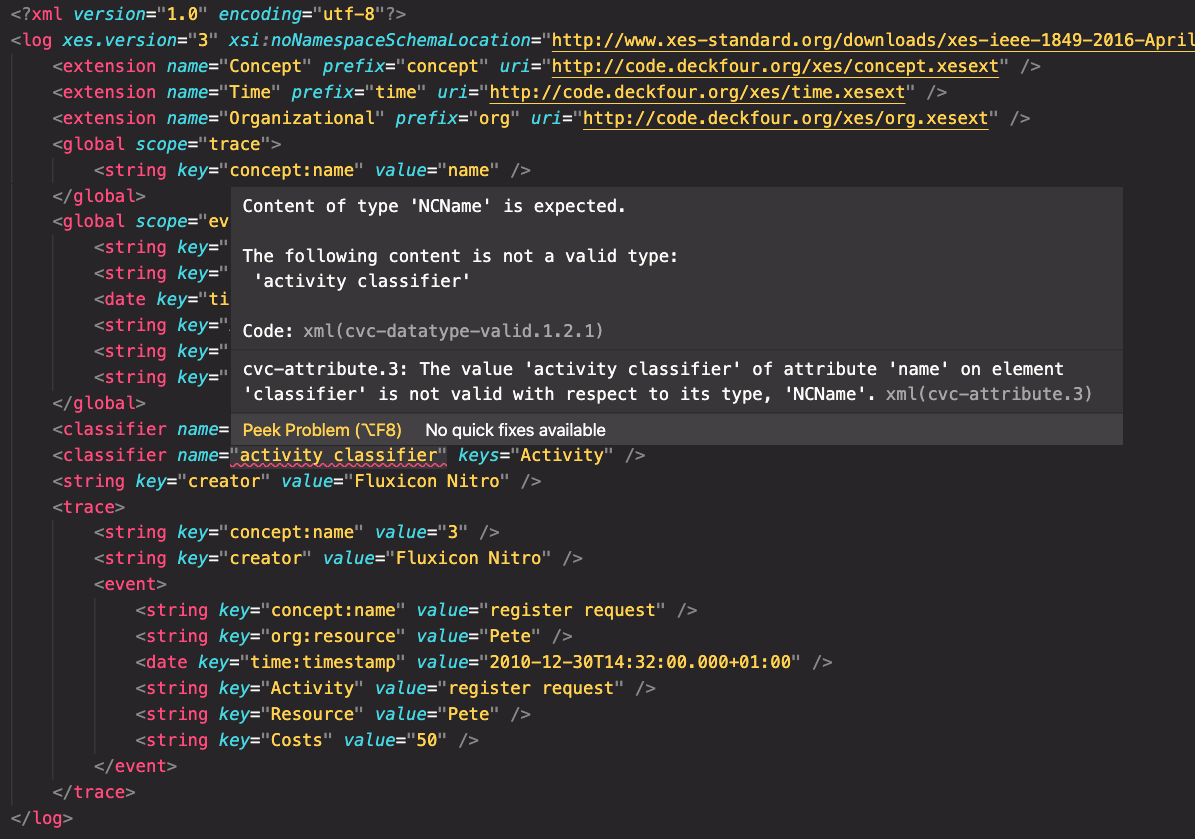To prevent spam users, you can only post on this forum after registration, which is by invitation. If you want to post on the forum, please send me a mail (h DOT m DOT w DOT verbeek AT tue DOT nl) and I'll send you an invitation in return for an account.
What exactly are classifiers in XES?
in Event Logs
Currently reading up on the published XES standard, but having a hard time grasping what trace and event classifiers are. The document is not very detailed when it comes to exactly how they are implements and i suspect this is by design.
The exact wording in the specification being "The identity of the event shall be derived from the actual values of the attributes with these keys".
Derived how?
Would i be correct in assuming that these classifiers are typically just concatenated values, given that a event E1 and E2 pertaining to trace T1 should both share at least some part of the identity produced by the classifier?
This log originates from the process mining book, but does not conform to the current XES spec. I have not checked compatibility with any prior version of the spec and assuming that they have not introduced any breaking changes..

I would greatly appreciate any and all input that could help me resolve this confusion. I it might become clearer if i get to have a look at a up to date XES log that also conforms to the current specification.
The exact wording in the specification being "The identity of the event shall be derived from the actual values of the attributes with these keys".
Derived how?
Would i be correct in assuming that these classifiers are typically just concatenated values, given that a event E1 and E2 pertaining to trace T1 should both share at least some part of the identity produced by the classifier?
Here is a very reduced example from http://www.processmining.org/event_logs_and_models_used_in_book with the classifiers in bold.
<?xml version="1.0" encoding="utf-8"?>
<log xes.version="3" xsi:noNamespaceSchemaLocation="http://www.xes-standard.org/downloads/xes-ieee-1849-2016-April-15-2020.xsd" xmlns:xsi="http://www.w3.org/2001/XMLSchema-instance">
<extension name="Concept" prefix="concept" uri="http://code.deckfour.org/xes/concept.xesext" />
<extension name="Time" prefix="time" uri="http://code.deckfour.org/xes/time.xesext" />
<extension name="Organizational" prefix="org" uri="http://code.deckfour.org/xes/org.xesext" />
<global scope="trace">
<string key="concept:name" value="name" />
</global>
<global scope="event">
<string key="concept:name" value="name" />
<string key="org:resource" value="resource" />
<date key="time:timestamp" value="2011-04-13T14:02:31.199+02:00" />
<string key="Activity" value="string" />
<string key="Resource" value="string" />
<string key="Costs" value="string" />
</global>
<classifier name="Activity" keys="Activity" />
<classifier name="activity classifier" keys="Activity" />
<string key="creator" value="Fluxicon Nitro" />
<trace>
<string key="concept:name" value="3" />
<string key="creator" value="Fluxicon Nitro" />
<event>
<string key="concept:name" value="register request" />
<string key="org:resource" value="Pete" />
<date key="time:timestamp" value="2010-12-30T14:32:00.000+01:00" />
<string key="Activity" value="register request" />
<string key="Resource" value="Pete" />
<string key="Costs" value="50" />
</event>
</trace>
</log>
This log originates from the process mining book, but does not conform to the current XES spec. I have not checked compatibility with any prior version of the spec and assuming that they have not introduced any breaking changes..

I would greatly appreciate any and all input that could help me resolve this confusion. I it might become clearer if i get to have a look at a up to date XES log that also conforms to the current specification.
Comments
-
Hi,The logs in the book may not conform to the IEEE XES standard, as they predate the IEEE XES standard.An event classifier is just a list of attribute keys, like "concept:name lifecycle:transition". Discovery algorithm are encouraged to use event classifiers instead of plain attributes. The log can then inform the discovery algorithm which combinations of attributes make sense as the activity name. If a discovery algorithm would use the example event classifier, typical values for the activity names could be "A+complete" and "B+start" (assuming "+" is used to glue the values of concept:name and lifecycle:transition together).A trace classifier is also just a list of attribute keys, but its use is different. The IEEE XES standard allows for events that are children of the log. Usually, events are children of a trace. For such 'trace-less' events, the trace classifier can be used to group these vents into traces. If the value of the trace classifier for two events is the same, then they belong to the same trace.Kind regards,Eric.
Howdy, Stranger!
Categories
- 1.6K All Categories
- 45 Announcements / News
- 225 Process Mining
- 6 - BPI Challenge 2020
- 9 - BPI Challenge 2019
- 24 - BPI Challenge 2018
- 27 - BPI Challenge 2017
- 8 - BPI Challenge 2016
- 68 Research
- 1K ProM 6
- 394 - Usage
- 288 - Development
- 9 RapidProM
- 1 - Usage
- 7 - Development
- 54 ProM5
- 19 - Usage
- 187 Event Logs
- 32 - ProMimport
- 75 - XESame
